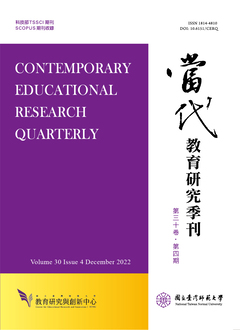

研究目的
本文旨在探討 J. Bruner 庶民教學觀的核心概念、理論基礎、研究應用,以及其在臺灣十二年國民基本教育課程綱要(簡稱:108 課綱)變革中的意義與影響。
研究設計/方法/取徑
本文採用詮釋循環方法,強調文件之間的「互為正文性」,透過在整體與部分之間來回雙向思考的動態過程,在文本的不同層次之間進行對話,進一步深化對文本的理解,揭示文本中隱含的意涵和內在邏輯,分辨異同並統整其相互關聯性,突顯隱而未見的論點,形成合理綜述。
研究發現或結論
本文發現Bruner的庶民教學觀強調文化背景在教育中的重要性,並為教師在設計素養導向教學活動中提供理論支持,有助於促進學生在文化脈絡中的學習。針對 108 課綱的素養導向教學設計,教師應靈活運用教學策略,將知識與文化脈絡結合,運用鷹架策略,引導學生思考、探究,培養學生的批判性思維和問題解決能力,以促進學生的全人發展,從而應對未來挑戰。
研究原創性/價值
本文系統性地將 Bruner 的庶民教學觀與 108 課綱中的素養導向教學實踐進行結合,特別是對庶民教學觀在多元文化背景下的應用進行深入探討,有其原創性。因此,本文應可為當前臺灣課程改革的實踐提供新的理論框架,也可為教師提供有效的理論依據和實踐指南,因而有助於在多元文化背景下促進學生的批判性思維、創造力及全人發展。
教育政策建議或實務意涵
本文建議教育執事者應鼓勵學校在課程設計中融入多元文化元素,通過結合文化心理學視角,培養學生的全球視野和文化敏感度,以促進學生的全人發展並減少文化偏見。其次,應提升教師專業素養,透過實務與政策上的支持,幫助教師更有效地面對學生的多樣性需求。第三,應制定支持教育科技與庶民教學觀結合的政策,鼓勵開發個性化學習策略,根據學生需求與情境靈活應用教學工具,以提升整體教學效果。
Purpose
This article explores the core concepts, theoretical foundations, and research applications of Bruner’s folk pedagogy, as well as its meaning and impact on the reform of Taiwan’s 12-year National Basic Education Curriculum (hereinafter, “the 108 Curriculum”).
Design/methodology/approach
This article employed the hermeneutic circle method, emphasizing “intertextuality” between documents. Through a dynamic process of bidirectional thinking between the whole and the parts, a dialogue was conducted across different textual levels. This approach further deepens our understanding of the texts and reveals their implicit meanings and underlying logic. Differences and similarities were discerned and their interrelationships integrated, thus highlighting previously unnoticed arguments and forming a coherent synthesis.
Findings/results
Bruner’s folk pedagogy emphasized the importance of the cultural context in education and provided theoretical support for teachers in designing competency-based instructional activities. This approach facilitates students’ learning within a cultural framework. Regarding the competency-based teaching design in the 108 curriculum, teachers
should flexibly employ instructional strategies and integrate their knowledge into particular cultural contexts. Scaffolding strategies are recommended to guide students in thinking critically, exploring deeply, and developing problem-solving skills, thereby promoting their holistic development to effectively meet future challenges.
Originality/value
This article systematically combined Bruner’s folk pedagogy with the competency-based instructional practices outlined in the 108 curriculum, conducting an in-depth exploration of the implication of Bruner’s folk pedagogy in multicultural contexts, which contributed to its originality. Furthermore, this article potentially provides a new theoretical framework for the practical implementation of current educational reforms and offers teachers an effective theoretical basis and practical guidelines. Therefore, this article is intended to promote students’ critical thinking, creativity, and holistic development in a multicultural context.
Implications for policy/practice
This article suggests that educational leaders should encourage schools to integrate multicultural elements into their curriculum designs and foster students’ global perspectives and cultural sensitivity by incorporating cultural psychology perspectives. This approach is intended to promote students’ holistic development and reduce their cultural biases. Second, educational leaders should improve teachers’ professional competencies and help them address the diverse needs of students more effectively through both practical and policy support. Third, educational leaders should establish policies that support the integration of educational technology with folk pedagogy, encouraging the development of personalized learning strategies and the flexible application of instructional tools based on students’ needs and circumstances to improve overall teaching effectiveness.

本著作係採用創用 CC 姓名標示-非商業性 3.0 台灣 授權條款授權.
本刊國立台灣師範大學教育研究與創新中心
106台北市和平東路一段162號 | 電話: 02-7749-3670 | E-mail: cerecerq@gmail.com
教創中心 | 師大 | 電子報 | 線上投審系統
本刊由國家科學及技術委員會人文社會科學研究中心補助經費
© 2014 CERI-NTNU
